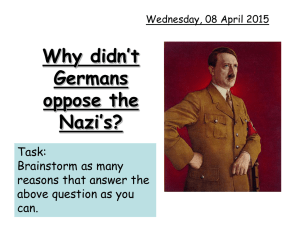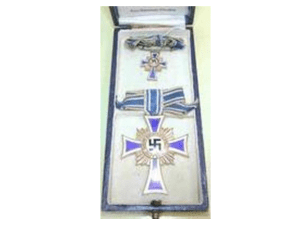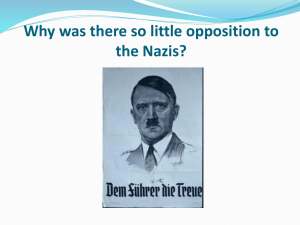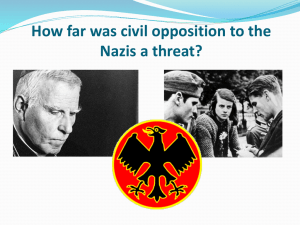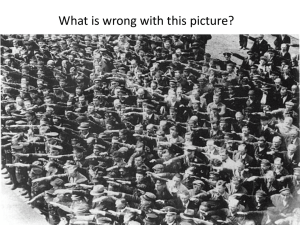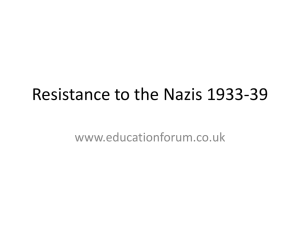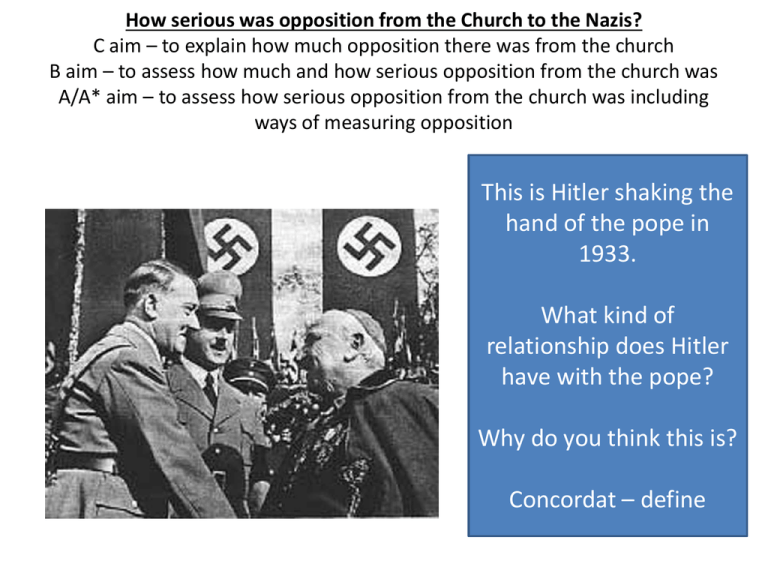
How serious was opposition from the Church to the Nazis?
C aim – to explain how much opposition there was from the church
B aim – to assess how much and how serious opposition from the church was
A/A* aim – to assess how serious opposition from the church was including
ways of measuring opposition
This is Hitler shaking the
hand of the pope in
1933.
What kind of
relationship does Hitler
have with the pope?
Why do you think this is?
Concordat – define
Feedback
• Mumin and Ewan – evaluate sources to link
back to question
• Geoffrey and Faaruq – explain in detail as if
reader doesn’t know anything about the topic
• Hasan and Scott – neaten presentation
(underline titles) and add detail to tasks
• All others – evaluate sources to explain why
they’re different and to answer the question
What do these photographs suggest about
the Nazis and the church?
What would you expect
a church to do?
Does this photograph
surprise you?
The Reich Church and German
Faith Movement
• Tried to get all of the protestant churches to
join together into an official Nazi Reich
Church.
• Most Germans stayed loyal to their local
churches rather than the new Reich church.
• Hitler tried to start a new religion called the
German Faith Movement, this wasn’t
Christian, it was based on ancient German
pagan mythology and on celebrating the
Aryan race. It was a failure.
• Most churchgoers supported the Nazis as they
agreed wit the Nazis traditional ideas – there
were simply some individuals who spoke out.
Summarise this point!
Galen
Why did Galen oppose
the Nazis?
How did he oppose the
Nazis?
What happened to
him?
How serious was this
opposition?
Galen was a Catholic Bishop of Munster, near the Rhineland. He was appointed
by Pope Pius XI, who had signed the Concordat, and the SA attended his
consecration. Galen made sure students would still be taught Catholicism in
Catholic schools from 1933. From 1934 he criticised the Nazis racial
ideologies and arguing that it was ridiculous to refuse the old testament
because it was Jewish. In January 1934 he gave a sermon openly criticising
Nazi racial policy, particularly the idea that disabled children should be
euthanised. In 1936 the Nazis tried to remove Catholic crucifixes from
Catholic schools, Galen led a protest against it and eventually they were
replaced. The SS visited him to try to pressure Galen into renouncing his
statements against Nazi ideology in 1934. He refused despite the threat of
violence. Galen helped the pope in Rome to research and write the 1937
encyclical which criticised what the Nazis were doing. In response the Nazis
arrested and intimidated Catholic clergy for being loyal to Rome instead of
Germany.
In 1941 Galen now criticised the lawlessness of the Gestapo – they kept taking
over church property and using it for whatever they liked. He also said that
the Nazis were murdering disabled children in the T4 Euthanasia
Programme, argued that the Nazis were threatening human rights and that
Christians should resist the taking of human life. The sermons were printed
and distributed illegally. He also began to criticise forced sterilisation and
concentration camps.
The Nazis didn’t arrest Galen because it could have caused open rebellion – he
was very popular in Munster and had a lot of followers. Soon Munster was
bombed terribly. The Nazis prevented him publishing, speaking to large
groups or travelling to other towns and cities – so silence him that way.
Niemoller
In Germany, they came first for the Communists, And I didn’t speak up
because I wasn’t a Communist...
When they locked up the social democrats,
I remained silent;
I was not a social democrat.
...then they came for the Jews, And I didn’t speak up because I wasn’t a
Jew...
When they came for me, there was no one left to speak out.
Niemoller
•
Why did Niemoller
oppose the Nazis?
How did he oppose the
Nazis?
What happened to him?
How serious was this
opposition?
Niemoller wanted Germany to have a strong
leader. He initially voted for the Nazis as they
offered this and said that they would support
Christianity. Niemoller didn’t like the German
Christians – a pro-Nazi Christian faction – as
they seemed to follow Nazi racial ideology and
German culture more than their own religion –
they even said they would reject the old
testament because of its Jewish associations.
Niemoller set up the Confessing Church to
oppose it – he argued that he wanted to focus
on Christianity, avoid the politicisation of
church leaders and welcome converted Jews.
Niemoller then realised he was being spied on
by the Gestapo. He became increasingly critical
in his sermons in Berlin. He continued to
preach and gain more supporters. Kn 1937 he
was arrested and eventually sent to
Sachsenhausen concentration camp. He
survived the war.
Bonhoffer
• Also a founding member of the
Confessing Church.
• Like Galen he also opposed
Hitler’s euthanasia programme
and the Nazis genocidal
programme from 1939
• He was also involved in a plot to
assassinate Hitler with the
German Military Office in 1943
and was arrested by the
Gestapo for this. He was
executed for this 2 weeks before
WWII ended.
Why did Bonhoffer
oppose the Nazis?
How did he oppose the
Nazis?
What happened to him?
How serious was this
opposition?
Why did the church oppose the Nazis?
How did they oppose the Nazis?
What happened to them?
How serious was this opposition?
How serious was opposition from the church?
• It is difficult to determine congregation numbers. But
we can look at the religious leaders...
– Number of Protestant pastors: 18,000
– Number of these strongly adhering to German Christian
faction as of 1935: 3000
– Number of these strongly adhering to Confessing Church
faction as of 1935: 3000
• Number of these arrested during 1935: 700
– Number of these not closely affiliated with or adhering to
either faction: 12,000
How serious was opposition from the church to the
Nazis? Use these statistics to support your answer.
• http://www.bbc.co.uk/learningzone/clips/lack
-of-christian-opposition-to-hitler/3286.html
What do these sources suggest about
opposition to the Nazis from the
church?
How serious was opposition from the Nazis?
• Point about young people
answering the question
• Evidence (source)
• Explanation (evaluation and
own knowledge)
• Evidence (source)
• Explanation (evaluation, own
knowledge and cross
reference)
• Link back to question
• You’ve just written a
paragraph!
How serious was opposition from the Church to the Nazis?
C aim – to explain how much opposition there was from the church
B aim – to assess how much and how serious opposition from the church was
A/A* aim – to assess how serious opposition from the church was including
ways of measuring opposition
Put your cross on the line and
justify using the following
points.
C
There
wasn’t
very much
opposition
There was
a lot of
opposition
B
Opposition
was not a
very serious
threat to the
Nazis
Opposition
was a very
serious
threat to the
Nazis
1933 Concordat
Reich Church
Galen
Niemoller
Bonhoffer
A/A* - Explain how you would
measure opposition. Then
explain how serious opposition
from the church was.
Homework – Due Monday 13th October
• The New Deal solved the problems of
America’s Depression. How far do you agree
with this statement? (10 marks)
• Warning – you will have a knowledge test next
Wednesday on America, the Cold War and
Britain. It will be around 40 questions with a
short factual answer needed. You will have a
single on it. This is for you and I to identify
where gaps are in your knowledge.
How serious was opposition from young people to the Nazis?
C aim – to explain ways opposition from young people was serious and not serious
B+ aim – to give an overall and supported judgement
This was a typical timetable in a Nazi schools.
What do you notice about it?
Would it have reduced or increased opposition
from young people?
• The Nazis wanted to get the support of young people to make sure everybody
growing up would support the Nazis and ensure Nazism remained in Germany.
They got the support of young people by making sure lots of young people joined
the Hitler Youth. In 1923 Hitler Youth had 1000 members, by 1933 it had 2.3 million
members , by 1936 it had 5 million members when it became compulsory. All
schools also had to follow the Nazi curriculum which included teaching anti-Semitic
ideas.
• http://www.youtube.com/watch?v=A6z3LsUp35Y&safe=active 2 min 50s – Hitler
Youth
• http://www.youtube.com/watch?v=IPwpR0Bm9xQ&safe=active – 50s League of
German Maidens
• With your partner write down everything
which shows that there wouldn’t have been
much opposition from young people. Include
ideas about...
– The Nazis focusing on young people
– Hitler Youth
– League of German Maidens
– Education
Opposition from youth
The White Rose group was formed by around 20 students at Munich
University. They published anti-Nazi leaflets, but were discovered and
executed in 1943.
During the war, 'swing' groups were formed. These were more wealthy
young people who rejected Nazi values, had more casual sex, drank alcohol
and danced to jazz.
There were more violent groups called the Edelweiss Pirates. Most cities in
Western Germany had a small Edelweiss Pirates group – they were more
uncommon in East Germany. They daubed anti-Nazi slogans, sheltered
deserters and beat up Nazi officials. In 1944, the Cologne Pirates (the
Edelweiss Pirates based in Cologne) killed the Gestapo chief, so the Nazis
publicly hanged 12 of them.
• How did youth people oppose the Nazis?
• What kind of opposition was this?
• How serious was this opposition? Think about membership
numbers – joining the Hitler Youth was compulsory.
• Write a report by the Gestapo in 1944 explaining how
serious opposition was to the Nazis.
Assessing seriousness
• How do we assess how serious a threat is?
• How serious was the threat from young
people?
What do these sources suggest about how serious
opposition was to the Nazis from young people?
How serious was opposition from the Nazis?
• Point about young people
answering the question
• Evidence (source)
• Explanation (evaluation and
own knowledge)
• Evidence (source)
• Explanation (evaluation, own
knowledge and cross
reference)
• Link back to question
• You’ve just written a
paragraph!
How does this show there was
serious opposition?
How does this show there
wasn’t serious opposition?
Do these sources

